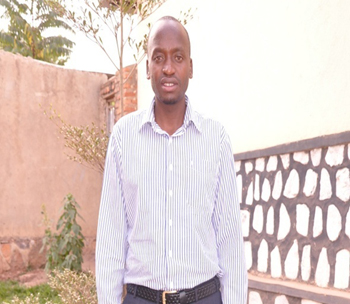
Gamariel Mbonimana
Though his students at Agohozo-Shalom Youth Village in Rwanda are all too familiar with genocide, Gamariel Mbonimana has found IWitness to be an engaging, powerful tool that sparks their curiosity.
Agohozo-Shalom Youth Village (ASYV), in Rwamagana, is home to more than 500 orphaned and vulnerable children. Mbonimana teaches General Paper courses to upper secondary students and was one of the first teachers to attend USC Shoah Foundation’s IWitness educator training sessions at Kigali Genocide Memorial in 2013.
After learning how to use IWitness to teach his students about genocide, Mbonimana immediately wanted to incorporate it into his own classroom. He takes his students to the school’s computer lab to watch testimonies and complete IWitness activities about both the Rwandan Tutsi Genocide and the Holocaust. Mbonimana said he likes that students have choices within the activities of which videos to watch, and they can watch them as many times as they need in order to understand and answer the questions that follow.
The students respond to questions about propaganda and discrimination, unity, reconciliation and hope for the future, as well as their own personal reflections on the testimonies they’ve watched.
Mbonimana said most of his students know about the Rwandan Tutsi Genocide from hearing stories about it throughout their lives and visiting memorial centers. But he knows IWitness is uniquely effective because they are curious and enthusiastic about the activities before, during and after the lesson.
“Therefore during IWitness activities, as expected, no student has been reported as having trauma, fear, stress, phobia, illusion or hallucinations as results of using IWitness,” Mbonimana said. “Of course students are emotionally engaged and this emotion serves to develop their attitudes and not to destroy their personality.”
He said that all students around the world who are studying the Holocaust and Rwandan Tutsi Genocide should use IWitness; the testimonies are “engaging, compelling and inspirational.”
“It also brings educators and their students together at the intersection of genocide and history education,” Mbonimana added. “In short, working with visual testimony makes sense because it engages students cognitively, emotionally and spiritually, and can effect change in cognition, values and attitudes.”